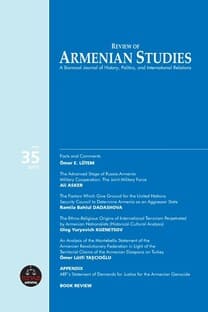OTTOMAN ARMENIAN INTRICATE RELATIONS WITH WESTERN POWERS BEFORE AND DURING THE PEACE SETTLEMENTS OF THE FIRST WORLD WAR
OTTOMAN ARMENIAN INTRICATE RELATIONS WITH WESTERN POWERS BEFORE AND DURING THE PEACE SETTLEMENTS OF THE FIRST WORLD WAR
When the First World War brought the two imperialistic blocks ofEurope face to face, the clashing interests of each included the dissolution ofthe Ottoman Empire. The extremist Armenians of the Empire were already anarmed force committed to the Allies when the Ottoman Empire, siding with theGerman block, had entered the war. Particularly at the Russian front theywholeheartedly contributed to the Allies, with the anticipation of anindependent Armenia including Eastern Turkish provinces. Their anticipationsfor territorial claims increased with the Wilsonian principles and the ambiguousArticle 7 in the Armistice of Mudros following the Ottoman defeat. However, theattitude of the Bolshevik Government in the aftermath of the RussianRevolution and the Turkish nationalists’ resistance to the occupations in thewake of the Armistice caused the Allies to approach Armenian demands withmore caution during the Paris Peace Conference. With the Turkish resistancehaving turned into an organized independence war under the leadership ofMustafa Kemal Pasha and with the defeat of the Armenians in the East, theGreat Powers reached a consensus in Paris that the Armenian demands werebeyond anything to be realized. Upon the defeat of the Armenians the Treatyof Gyumri was concluded whereby the Eastern border of Turkey was secured.The stance of the Allied Powers toward the Armenian delegations continuedthroughout the Paris Peace Conference. It was not until the Lausanne Treatysigned on the 23rd of July 1923 that an Armenian expectation of anindependent state encompassing Turkish provinces was put to an end
Keywords:
Armenians, Allies, Paris Peace Conference Turkish nationalists,
- ISSN: 1303-5304
- Yayın Aralığı: Yılda 2 Sayı
- Başlangıç: 2002
- Yayıncı: Terazi Yayıncılık Basım Dağıtım Danışmanlık Eğitim Organizasyon Matbaacılık Kırtasiye Tic. Ltd. Şti.
